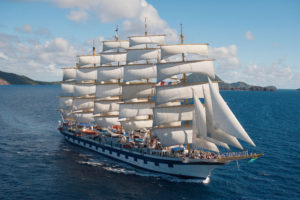
Terre de Haute, Iles des Saintes in the French Caribbean, is an idyllic spot open only to small ships. Photo by Catharine Norton
For your next trip, should you take a cruise, a train, a plane, drive a car — or try something different, like taking a cargo ship or long-distance passenger ferry?
That depends to a large degree on where you’re going and what kind of travel experience you hope to have. Different areas of the world — as well as differing expectations — lend themselves to different forms of transportation.
In this series, we’ll take a look at different options for getting around various areas of the world — starting with the Caribbean.
Navigating The Caribbean
This one is easier than most, or so it seems at first glance.
If you’re headed to one island in search of a beach resort or some cultural immersion, you’ll fly there and maybe rent a car or moped.
If you’d like to sample a number of different islands and enjoy a sea-going experience, you’ll take a cruise (if you don’t have your own sailboat).
The Caribbean remains the cruise capital of the world , offering warm turquoise waters and a pearl-like string of islands featuring a spicy stew of varied landscapes and peoples.

The incredible Royal Clipper sails the Caribbean. Photo from Star Clippers.
But then it starts getting a little more complicated.
When flying to one island, for instance, if your main interest is hanging out at the beach, you may want to choose a charter flight that comes all-inclusive with resort lodging and food. This could save you money, but your cultural immersion quotient will be nil.
For the latter, you’ll need to forego the charter jet and the resort life, take a regular commercial flight, and probably rent a car or moped or ride local buses to get around.
Cruise Choices — A Matter of Size
A Caribbean cruise is not just a cruise — it involves a sea of choices.
With cruises, you’ll need to choose between big ships — some as huge as floating islands themselves — and small ships, usually sailing vessels. They promise entirely different experiences.

The Pitons, St. Lucia. Photo by Clark Norton
The big ships can only dock at big ports, where shore excursions may whisk you away for a few hours of swimming with manta rays or climbing waterfalls, or where you can roam through towns in search of shops, bars, or historic sites.
Big ports include Grand Cayman in the Cayman Islands; St. Maarten; Ocho Rios, Jamaica; Cozumel, Mexico; and Nassau in The Bahamas (technically not part of the Caribbean, but often included on Caribbean itineraries).
You’ll encounter your share of guides, vendors, and maybe some locals in the bars, but you won’t really have time to absorb much of the culture. Chances are that you’ll travel round-trip from a U.S. port, most likely from South Florida but perhaps from New Orleans or Texas.
Meanwhile, the small sailing vessels can (and usually do) dock or drop anchor in secluded coves or off-the-beaten path villages. You’ll get to know most of your fellow passengers, whose (hopefully convivial) conversation may provide most of the entertainment on board. You won’t find the stage shows, casinos or other embellishments that you’ll find on the big ships. And you’ll probably embark and disembark in the islands themselves.
Geography Plays a Role
Caribbean cruises usually fall into one of three rough categories: Western, Eastern, or Southern Caribbean, though sometimes the latter two overlap.

Lush Dominica. Photo by Clark Norton
Most Western Caribbean cruises are the cheapest of the three, last a week or less and visit a familiar threesome of Jamaica, the Cayman Islands, and Cozumel or Costa Maya, Mexico. Some cruise lines also include stops in Central America or make port in Key West, Nassau, or at a private island en route, adding further variety.
(Havana, Cuba, has recently been added to a number of Caribbean itineraries, including Western Caribbean routes.)
Eastern Caribbean itineraries typically last seven to 10 days and often include Puerto Rico and nearby points east: the U.S. Virgin Islands, the British Virgins, St. Maarten/St. Martin, St. Bart’s, Antigua and St. Kitts. The British Virgin Islands are particularly spectacular, especially as seen from the water or a white sand beach.
These itineraries are good for island-hopping — distances between them aren’t great — and reward those with diverse interests, from the history of Old San Juan, Puerto Rico, to shopping and swimming on St. Martin.
While Southern Caribbean itineraries sometimes include St. Martin and the Virgin Islands, they also reach much farther south to Barbados, Grenada, St. Vincent, Dominica, St. Lucia, Martinique, Curacao and Aruba — an enticing mix of lush and arid landscapes as well as British, French and Dutch architectural and cultural legacies.
Because of the greater distances from U.S. ports, Southern Caribbean sailings may extend from 10, 12 or to 14 days or more. Cruise ship traffic tends to be lighter than in the areas farther north, and more of the cruises — including virtually all the small ship cruises — embark in the islands.

Alexander Hamilton was born on Nevis.
But if you arrive a day or two early, you can explore the island of embarkation a bit before the cruise — by car, bus, moped, or even on bare feet, with dishwater warm waters lapping the sand below.
A final note: it’s entirely possible to do some island-hopping in the Caribbean without taking a cruise or sailing your own boat. Small ferries connect several of the islands that are close together.
For instance, I hopped a short ferry from the island of Anguilla once to spend an afternoon in St. Martin. I was just about the only local onboard, and it was great — even though the ride was all too short.
On another occasion, I took a round-trip ferry from St. Kitts to Nevis — two islands that together form a country. Again, the ferry was filled with locals and seemed reasonably seaworthy.
Next Up: Getting Around The Mediterranean












One Response to Caribbean Transport: What’s Best for You?